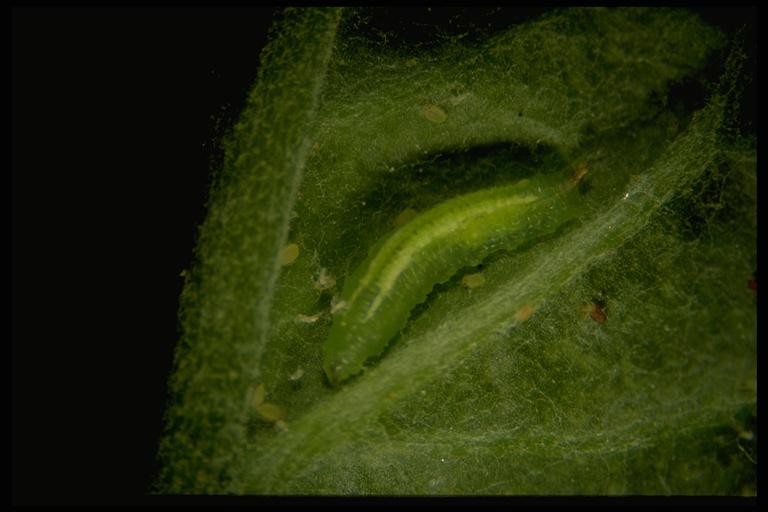
A syrphid fly, (Diptera: Syrphidae), adult. Photo by Drees.
Common Name: Syrphid fly, hover fly, flower fly
Scientific Name: Varies
Order: Diptera
Description: This is a large group of medium to large flies, ranging from 1/4 to 3/4 inch long. Most adult hover flies are black or brown with yellow banded abdomens and body markings, superficially resembling bees and wasps except that they have only two wings that are not held over the back of the body when at rest. Some species are hairy and have a long, thin abdomen. Antennae are short (not elbowed) and the last segment bears a strong hair (seta). Larvae of most species are legless spindle-shaped maggots and vary in color from creamy-white to green or brown.
Hover flies can be distinguished from other groups of similar flies by studying the wing venation: they have a isolated (spurious) vein in the wing between the third (radius) and the fourth (media) longitudinal veins.

A syrphid fly, (Diptera: Syrphidae), maggot preying on yellow pecan aphid. Photo by Drees.
Life Cycle: Biology and developmental times vary between species and because of environmental conditions and availability of food. In general, females lay single white eggs on leaves near aphid infestations or near other suitable food source for that species. Larvae or maggots hatch from eggs in about 3 days. Larvae develop through several stages (instars) over a period of 2 to 3 weeks before pupating, either on the host plant or in the soil. The skin of the last stage larva forms the tan-brown teardrop shaped puparium. Adults emerge in one to two weeks unless the pupal stage remains through the winter. Up to seven generations occur annually.
Habitat and Food Source(s): Larvae have chewing (teasing) mouthparts; adults have sponge-type mouthparts similar to house flies. Adult flies can be found hovering around flowers, feeding on nectar and pollen. They are often attracted to honeydew covered leaves characteristic of infestations of sucking insects such as aphids. Legless larvae of these (Syrphinae) species are slug-like, adhering to leaf surfaces of infested plants while searching for aphids and other suitable prey (small caterpillars, thrips, etc.). Each larva can consume up to 400 aphids during development. Larvae of other species feed in the nests of ants, termites or bees, and others live in decaying vegetation and wood. One group, Eristalis spp., are called rattailed maggots because of an unusually long breathing tube from the back of their bodies used to breath as they dwell in highly polluted water. Adults of this genus resemble bees and are known as drone flies. Larvae of a few species feed on live plants. Larvae and pupae can be found by inspecting aphid-infested plants or searching through other suitable habitats (e.g., decaying wood, algal mats).
Pest Status: Generally considered beneficial because the larval stages of many species are predaceous on insect pests such as aphids and adults pollinate flowers; medically harmless adults and larvae of most species; larvae of one group of syrphid flies, called “rattailed maggots,” can survive in human digestive tracts.
For additional information, contact your local Texas A&M AgriLife Extension Service agent or search for other state Extension offices.
Literature: Borror et al. 1989; Mahr 1995. Swan & Papp 1972.